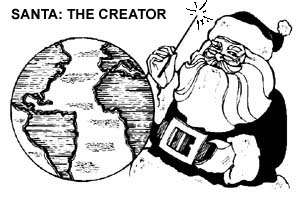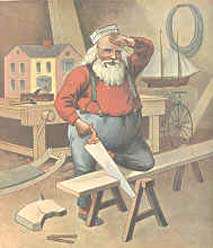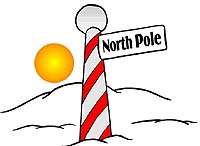Did you know that we can prove from the Scriptures that Jesus was not born in the winter?
Did you know that there is a holiday that was instituted over a thousand years before Jesus was born that prophetically foreshadowed the circumstances of His birth?
The truth is that there was a late December pagan holiday that was celebrated long before Jesus was ever born. The Roman Catholics decided to "christianize" that pagan holiday starting in 336 A.D. as a celebration of the birth of Christ. The Christian Church and much of Judaism is entrenched deep in the ancient Babylonian mystery religion, only today it is referred to as 'culture' or 'traditions.' Most Christians and Jews either don't know or care to know the truth of these pagan ties.
A recent news article from the Scripps Howard News Service states in their article, "Christmas Celebration Crosses All Faiths."
- "Christmas remains America's favorite holiday-a religious celebration that transcends the nation's increasingly multicultural society. Eighty-three percent of the adult residents of the United States-including Jews, Muslims and atheists-say they put a decorated tree in their homes. Fifty-nine percent say there is no holiday they love more than Christmas."
 What is Christmas and from where did it originate? Yule is the Chaldean name for 'infant' or 'little child.' In ancient Babylon, the 25th of December was known as Yule day or the birth of the promised child day. This was the day of the birth of the incarnate sun, who appeared as a baby child to redeem a world bound in darkness. It was an essential belief of the Babylonian religious system, that the sun god, also known as Baal, was the chief god in a polytheistic system. Tammuz was also worshipped as the god incarnate, or promised baby son of Baal, who was to be the Savior of the world.
What is Christmas and from where did it originate? Yule is the Chaldean name for 'infant' or 'little child.' In ancient Babylon, the 25th of December was known as Yule day or the birth of the promised child day. This was the day of the birth of the incarnate sun, who appeared as a baby child to redeem a world bound in darkness. It was an essential belief of the Babylonian religious system, that the sun god, also known as Baal, was the chief god in a polytheistic system. Tammuz was also worshipped as the god incarnate, or promised baby son of Baal, who was to be the Savior of the world.We find in the Catholic encyclopedia that Christmas was not even among the earliest church festivals. It was not until the latter part of the fourth century that the Roman Church began observing December 25th as Jesus' birthday. By the fifth century A.D., the Roman Church ordered the birth of Messiah to be forever observed on December 25th. At the time of this decree, the Roman Church knew full well that the pagan religious cults throughout the Roman and Greek worlds celebrated the pagan sun god, Mithra, on this self same day. This winter festival was known as the Nativity of the Sun. It was also known in the Roman Empire as Saturnalia [another name for sun worship].
Note: In 46 BC, when the Roman "Julian Calendar" was adopted, December 24th was the shortest day of the year. Therefore, December 25th was the first annual day that daylight began to increase. Thus, the origin of the REBIRTH or Annual Birthday of the Invincible SUN.
In accordance with the Roman "Julian calendar," the "Saturnalia" festival appears to have taken place on December 17th; it was preceded by the "Consualia" near December 15th, and followed by the "Opalia" on December 19th. These pagan celebrations typically lasted for a week, ending just before the late Roman Imperial Festival for "Sol Invictus" (Invincible Sun) on December 25th.
In 1582 AD. Roman Catholic Pope Gregory the XIII caused the current "Gregorian Calendar" to be adopted, in order to eliminate the solar time shift error introduced by the "Julian Calendar."
By December 1582 AD the shortest day of the year had shifted 12 days on the Roman "Julian Calendar" to Wednesday, December 12, 1582.
 However, the Original December 25th 'Birth Date' was retained for all pagan Sun gods by the Roman "Saturnalia" and "Sol Invictus" traditions; which were now called the "Twelve Days of Christ Mass."
However, the Original December 25th 'Birth Date' was retained for all pagan Sun gods by the Roman "Saturnalia" and "Sol Invictus" traditions; which were now called the "Twelve Days of Christ Mass."On the new Roman Catholic Gregorian calendar the shortest annual day was numerically shifted back 10 days to the 22nd of December, where it remains to this day; while the original order of the days of the week remained unchanged.
Therefore, Wednesday, December 12th, 1582 AD, became Wednesday, December 22nd, 1582 AD, and the True Sabbath Day remained unchanged.
Yahweh, the Only True Self-existent Eternal Creator, would never have allowed The True Messiah to be born on or near the December 25th birthday period of the pagan Sun gods; during the time in which virgins were sacrificed, murder was commonplace, and orgies the norm. This would be an entirely unacceptable association.
The winter festival was very popular in ancient times, and marked a time of rejoicing and festivity. Much of our present day customs involved in the Christmas season are a direct inheritance of the Roman winter festival of Saturnalia. These days involved gift giving, colored lights to ward off evil spirits, festive meals, and of course, decorated trees.
The present day Christmas tree also goes back to the worship of sacred trees in the ancient Babylonian system. The green evergreen symbolized the incarnate Baal coming to life through the incarnate baby Tammuz. The custom of decorating and worshipping trees spread throughout the known world, with the variety of tree used selected according to the natural growth of each area of the world. The Druids worshipped the oak tree, the Egyptians worshipped the palm tree, while in Rome it was the fir tree.




There are at least ten references in the Bible warning that these green trees were associated with idolatry and pagan worship. Jeremiah 10:1-4 details the Israelites following the very pagan customs practiced today.
The very term, Christmas, comes from the sacred Christ-mass, where the Pope in the role of the High Priest of the mystery Babylon religion introduces the people to the concept of trans-substantiation. Using the wine and round wafers to reflect the life of Baal, the sun god, the name of Jesus replaces the ancient pagan custom. The wine and wafers are now said to be the transformation of the actual blood and body of Messiah within the person who ingests them. People, thereby, relive again and again the death and resurrection of the incarnate god.
Israelites performed this same ritual in their worship to the Queen of heaven and the incarnate god Tammuz.
 Calvin, in 1550, instigated an edict concerning church holidays. A ban was passed against observing various church festivals, which included Christmas. In a tract on the necessity of reforming the church, Calvin exclaimed: "I know how difficult it is to persuade the world that Yahweh disapproves of all modes of worship not expressly sanctioned by His Word." John Knox, in the Scottish reformation, repeatedly confronted the Catholic Church, contending that true worship must be instituted by God, not derived from the traditions of men. At the heart of his argument was an appeal to Torah, especially, references to Deuteronomy 4 and 12, which states that one must not add to nor subtract from God's word.
Calvin, in 1550, instigated an edict concerning church holidays. A ban was passed against observing various church festivals, which included Christmas. In a tract on the necessity of reforming the church, Calvin exclaimed: "I know how difficult it is to persuade the world that Yahweh disapproves of all modes of worship not expressly sanctioned by His Word." John Knox, in the Scottish reformation, repeatedly confronted the Catholic Church, contending that true worship must be instituted by God, not derived from the traditions of men. At the heart of his argument was an appeal to Torah, especially, references to Deuteronomy 4 and 12, which states that one must not add to nor subtract from God's word.John Knox, History of the Reformation in Scotland, 1950, Vol. 1, page 91 states the following: "That Yahweh's word damns your ceremonies it is evident; for the plain and straight commandment of Yahweh is, 'Not that thing which appears good in thy eyes, shalt thou do to the LORD thy Yahweh, but what the LORD thy Yahweh has commanded thee, that do thou; add nothing to it; diminish nothing from it.' Now unless that ye are able to prove that Yahweh has commanded your ceremonies, this His former commandment will damn both you and them."
The holidays of Christmas and Easter were banned from the Church of Scotland.
David Calderwood [1511-1651], representing the Scottish ministries, asserted in reference to Christmas and Easter: "The Judaical days had once that honor, as to be appointed by Yahweh Himself; but the anniversary days appointed by men have not like honor. This opinion of Christ's nativity on the 25th day of December was bred at Rome."
David Calderwood then exposed the Roman claims made for the 25th of December as the day of Messiah's birth. He argues that the Apostles never ordained it. He said the following: "Nay, let us utter the truth, December-Christmas is a just imitation of the December-Saturnalia of the ethnic [heathen] Romans, and so used as if Bacchus [another name for the sun god], and not Messiah, were the Yahweh of Christians."
George Gillespie [1613-1649], a premier Scottish theologian, wrote in a book published in 1637 called A Dispute Against the English Popish Ceremonies Obtruded Upon the Church of Scotland. "The holidays [reference to Christmas and Easter] take a severe beating on a number of accounts. Sacred significant ceremonies devised by man are to be reckoned among images forbidden in the second commandment in regards to worshipping idols."
It is certainly clear from all that we have read, that an end time apostasy has come upon both Jews and Gentiles. Both have strayed far from the original precepts of the faith, and there will be a heavy accounting before the LORD for this. These holidays represent only part of the great apostasy that has come upon God's people in the latter days.
Asatru
MandMEvangelists
Paganism/XmasHistory















 The ever-familiar holly plant that decorates our Christmas world has a very interesting history. A very interesting history indeed.
The ever-familiar holly plant that decorates our Christmas world has a very interesting history. A very interesting history indeed. 

 Holly lost its pagan associations and became a symbol of Christmas, with the sharply pointed leaves symbolizing the crown of thorns which Jesus was made to wear prior to his crucifixion, and the berries becoming a symbol of the
Holly lost its pagan associations and became a symbol of Christmas, with the sharply pointed leaves symbolizing the crown of thorns which Jesus was made to wear prior to his crucifixion, and the berries becoming a symbol of the









































